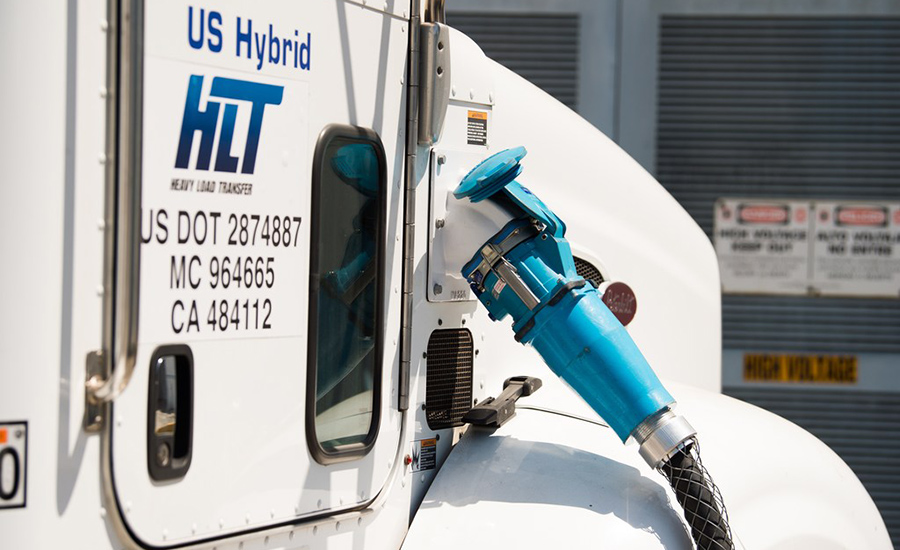California’s new rules mandating a switch to electric trucks have prompted concerns among construction and logistics firms. There is a worry that the new policy could lead to project delays and a spike in costs that could ultimately affect the state’s economy.
On April 28, the California Air Resources Board (CARB) approved a new set of rules, known as Advanced Clean Fleet, requiring the phase-in of zero-emissions vehicles (ZEV), banning the sale of diesel trucks by 2036 and requiring large trucking fleets to be all-electric by 2045.
Although large trucking firms and port dryage operators will be most affected by Advanced Clean Fleet, the regulation has implications for construction, as it aligns with other agency directives affecting off-road diesel engines.
“CARB has identified construction as a major opportunity for emissions reduction,” explains Brian Mello, Associated General Contractors of California’s vice president for engagement and regulatory affairs. “The challenge, though, is the industry’s ability to comply is constrained by several factors beyond their control.”
One concern is whether the state will have sufficient electrical infrastructure to support a steadily increasing demand for power to recharge ZEVs, particularly in remote areas. Although CARB has adopted ZEV compliance exemptions of up to five years to address electrical infrastructure construction and site electrification delays, Mello says the process of securing such an exemption from the Board would create a new, expensive administrative burden on contractors on top of their efforts to convert their fleets.
In addition to the lack of power, the ACG pointed out ZEV’s have other limitations in construction sites that include “the impracticality of hauling due to battery weight, potential damage to the battery packs, decreased operability during the summer, and inability to operate auxiliary equipment," the group said in a letter to the agency.
"The dramatic increase in cost would likely result in fewer projects being financed, further hindering the development of our state," AGC of California argued.
Rewriting the Rulebook
The new CARB regulations affects public agencies, dryage services and private “high priority fleets"—those that operate at least one vehicle in California and have either $50 million or more in gross annual revenues, or own, operate or direct 50 or more vehicles.
Beginning with the 2024 model year, these fleet owners will be required to phase in zero-emission vehicles (ZEVs) to replace conventional fuel medium- and heavy-duty on-road vehicles with a gross vehicle weight rating of an 8,500 lbs, as well as off-road yard tractors, and light-duty mail and package delivery with In addition, manufacturers will be restricted to selling only zero-emission medium- and heavy-duty vehicles in the state as of 2036.
While California is the only state allowed to set its own emission standards for motor vehicles, CARB’s adoption of Advanced Clean Fleets’ significantly tougher standards required prior endorsement from the U.S. Environmental Protection Agency. According to the Board, the new regulation will yield significant reductions in statewide emissions of nitrogen oxides and particulate matter, as well as the number of cardiopulmonary deaths and cases of respiratory illness, particularly in high-traffic areas near ports, highways and distribution centers.
Advocacy groups outside of the construction industry have expressed similar concerns. Along with citing the absence of sufficient electrical infrastructure, American Trucking Association President and CEO Chris Spear said in a statement that motor fleets “are just beginning to understand what it takes to successfully operate these trucks, but what they have learned so far is they are significantly more expensive, charging and refueling infrastructure is nonexistent.”
Spear added that ZEVs “are not necessarily a one-for-one replacement—meaning more trucks will be needed on California roads to move the same amount of freight.”
There is also the question of whether there will be enough ZEVs on the market to support such a large-scale changeover not just in California, but also the six other states that have vowed to enact similarly strict emission-reduction standards.
“We’re talking about a need for tens of thousands of vehicles that right now are not going to be readily available for the entire needs of construction in California,” says AGC of California CEO Peter Tateishi. “There needs to be flexibility on timeline based on market conditions and our capability to come into compliance when it’s not up to us.”
Advanced Clean Fleet is likely to face both legal and legislative challenges in an attempt to alter the regulations, or delay their implementation. Tateishi says his organization will keep its options open, including working with CARB on potential changes.
“We’re happy to comply with the agency’s emission reduction goals as long as we’re capable of doing so,” he says. “This is not the end of the conversation on our side.”


Post a comment to this article
Report Abusive Comment